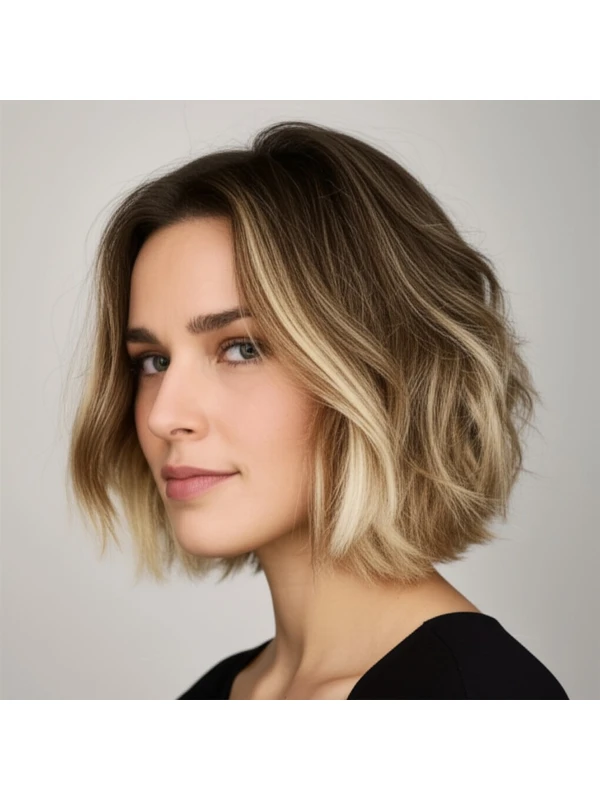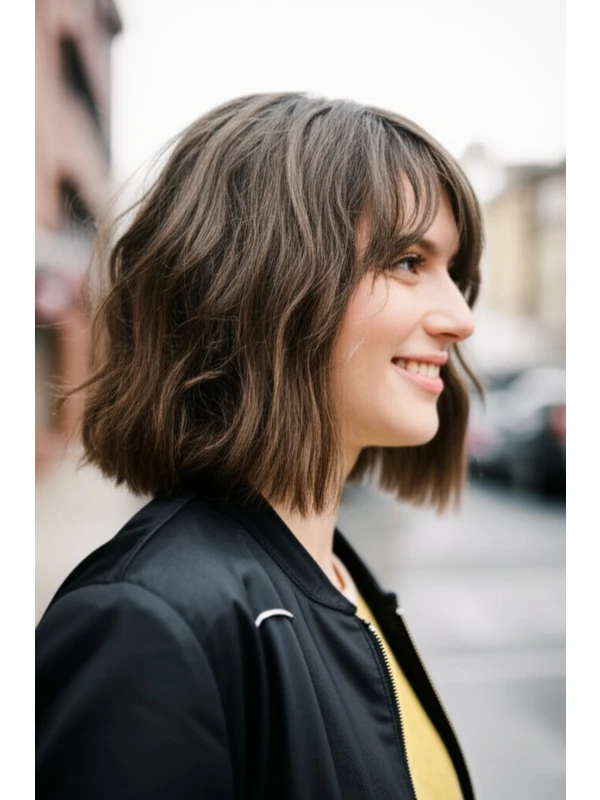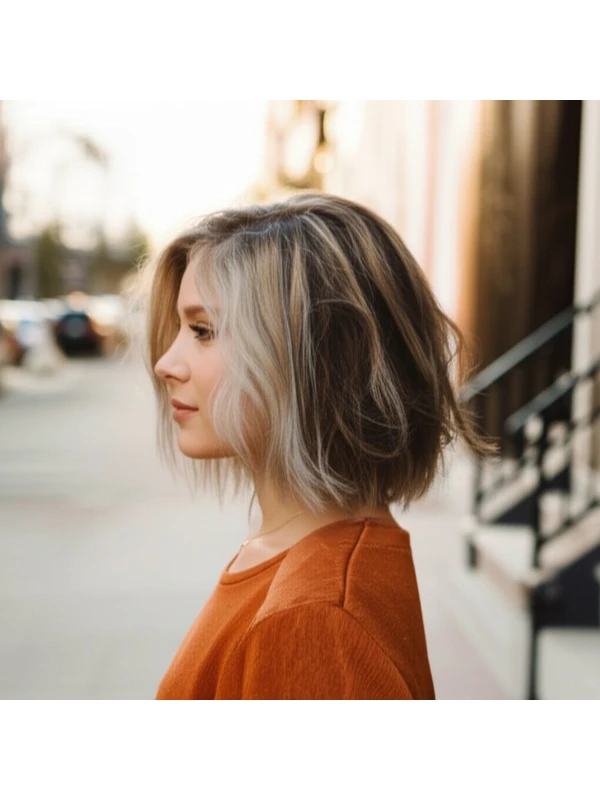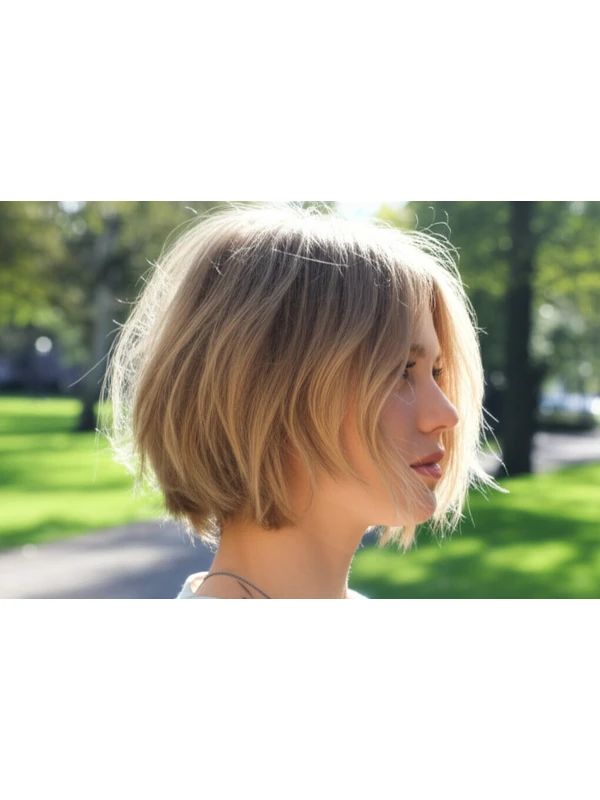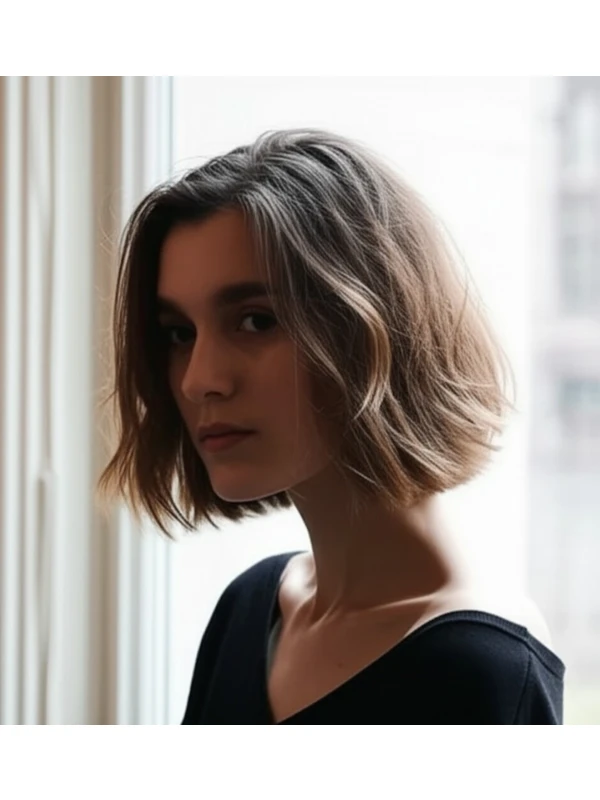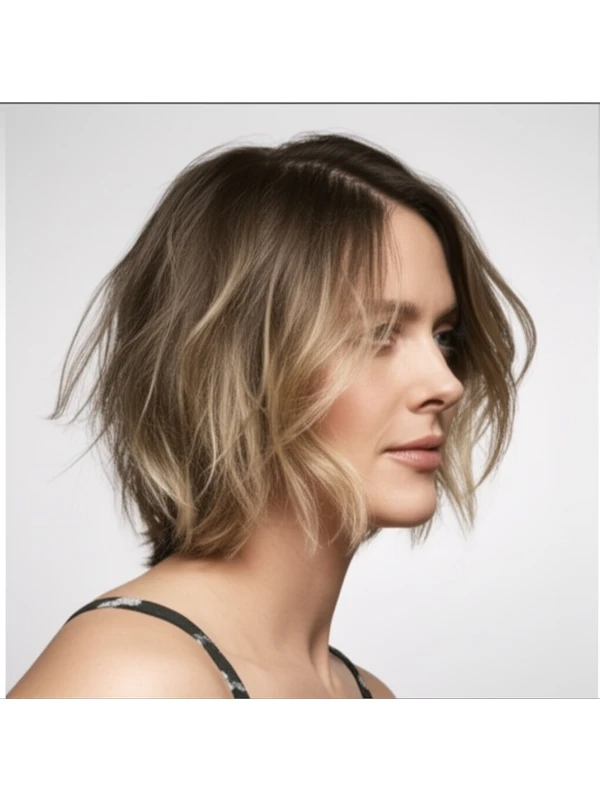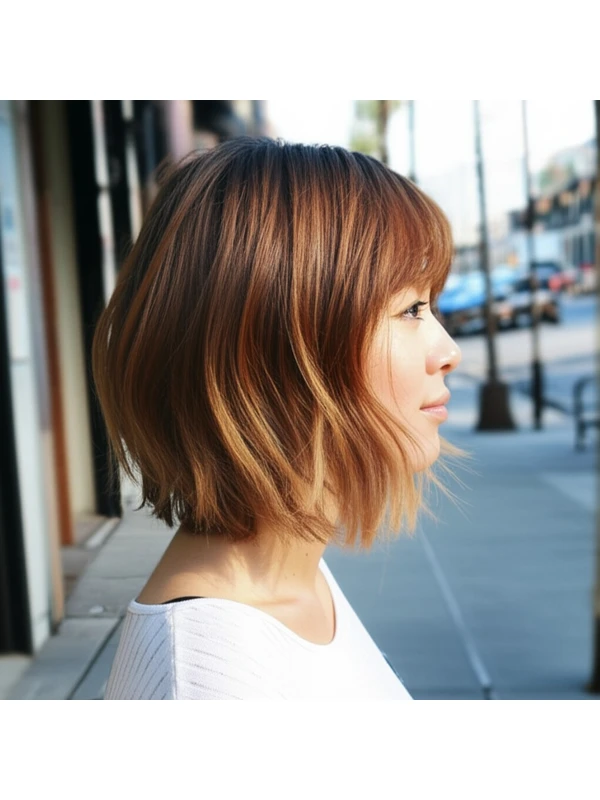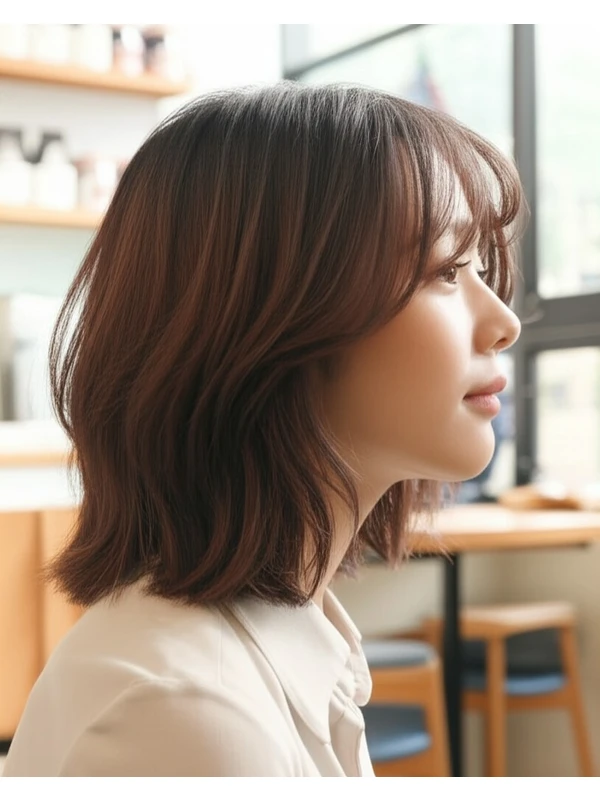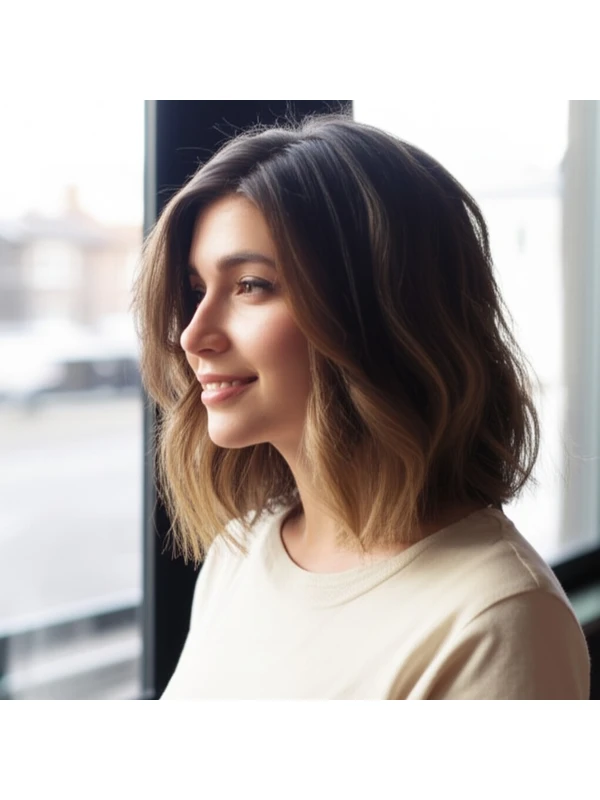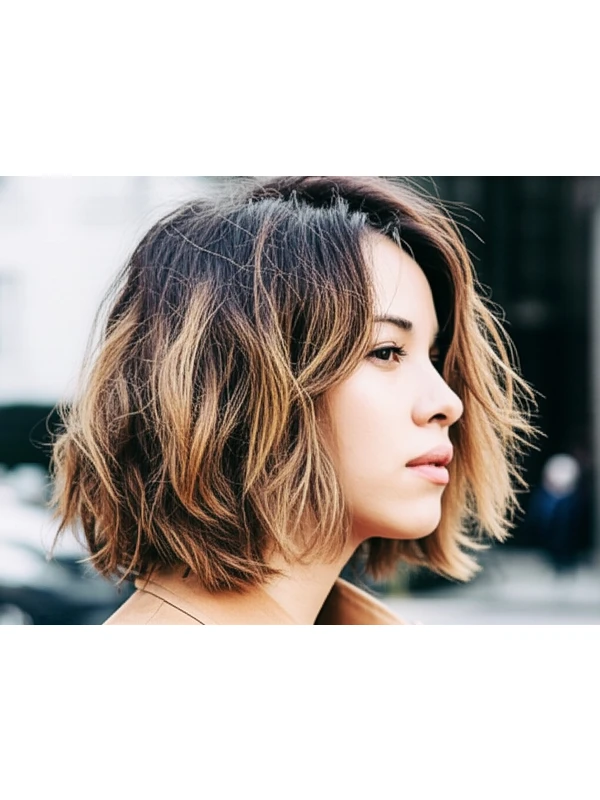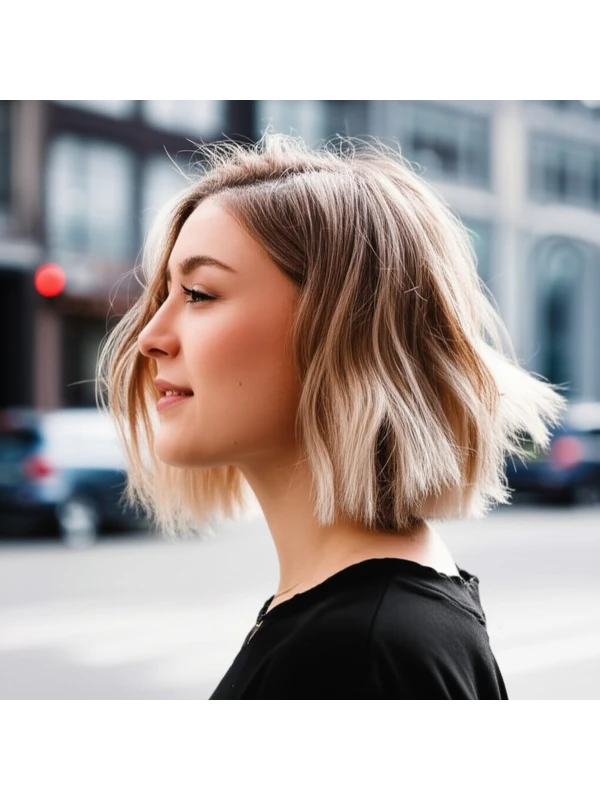#The Shattered Lob: A Modern Classic
The "shattered lob" is everywhere for a reason – it's effortlessly chic, adaptable to almost any hair type, and feels fresh without being overly trendy. But what is a shattered lob? Let’s break down everything you need to know about this versatile hairstyle.
#1) Background & Definition: What Makes It "Shattered"?
The shattered lob (short for long bob) isn't just any long bob; it's characterized by its deliberate, piecey texture and layers that create a deliberately undone look. Imagine the classic lob but with more movement and visual interest – like it’s been playfully “shattered” into softer shapes.
- Cut Geometry: The key is face-framing layers that are shorter around the face and gradually lengthen towards the back, creating a V or U shape when viewed from behind. The overall line isn't blunt; instead, it has subtle graduation.
- Key Features: Lots of texture, soft edges, movement, and a modern vibe. It’s meant to look lived-in and effortless – not perfectly polished (though you can polish it up!).
- Typical Length Ranges: Generally falls between the collarbone and just below the shoulders. 10–14 inches is a common range.
- Alternative Names: Textured Lob, Layered Lob, Piecey Bob, Undone Long Bob.
#2) Face Shape Fit: Finding Your Best Shattered Angle
The beauty of the shattered lob lies in its adaptability, but understanding how it interacts with your face shape can help you maximize its impact.
- Oval Faces: Lucky you! This style generally looks fantastic on oval faces. The layers add dimension and softness without needing much adjustment. A side part often enhances symmetry. Fringe Option: Curtain bangs or wispy, textured fringe work beautifully.
- Round Faces: The shattered lob can slim a round face by adding length and vertical lines. Avoid too much volume at the cheeks; focus on layers that draw the eye downwards. A slightly off-center part is flattering. Fringe Option: Longer, side-swept bangs soften fullness.
- Square Faces: Softening sharp angles is key. The shattered lob's layers help achieve this. Ask your stylist to round out the edges around your jawline. An asymmetrical cut (slightly shorter on one side) can also be very flattering. Fringe Option: A soft, blended fringe that isn’t too blunt will soften a strong brow and jawline.
- Heart Faces: The shattered lob balances a wider forehead with layers that frame the face and draw attention to the chin. Avoid excessive layering at the crown, which can exaggerate width. Fringe Option: Wispy side-swept bangs or a soft curtain bang work well.
- Diamond Faces: Similar to heart shapes, diamond faces benefit from softening angles. Layers around the cheekbones and jawline create balance. A middle part is often flattering. Fringe Option: A textured fringe that blends seamlessly with the layers can soften features.
- Oblong Faces: Add width with strategic layering at the sides of your face, avoiding too much length or volume on top to prevent elongation. Fringe Option: A blunt, straight-across fringe (if you're feeling bold!) can shorten an oblong face.
#3) Body Proportions & Height Guidance: Tailoring Your Lob
Your body type and height also influence how a shattered lob will look.
- Petite: A shorter shattered lob (collarbone length or slightly above) prevents the style from overwhelming your frame. Avoid excessive volume at the crown to maintain balance.
- Average Height: Most lengths work well! Experiment with different layer placements to find what best complements your features.
- Tall: A longer shattered lob (below the shoulders) can help visually shorten your torso and create a more balanced silhouette.
- Narrow Shoulders: Layers that add volume around the shoulder area will broaden them, creating a more proportional look.
- Broad Shoulders: Avoid overly voluminous layering at the shoulders; instead, focus on subtle layers that blend seamlessly with the overall shape.
- Short Neck: A lob hitting just above or at the collarbone elongates the neck visually. Avoid excessive volume at the back of the head.
- Long Neck: You can pull off longer lengths and more volume without looking elongated.
#4) Works Best With Hair Types & Densities: Finding Your Match
The shattered lob is surprisingly versatile, but understanding how it interacts with your hair type is crucial.
- Straight Hair: Layers will fall cleanly and create a sleek texture when styled.
- Wavy Hair: The layers enhance natural waves, creating effortless movement and definition. Air-drying often works wonders!
- Curly/Coily Hair: Layers can prevent the dreaded "pyramid" shape that can occur with curly hair. It’s essential to communicate your curl pattern and desired shrinkage to your stylist – shrinkage is a major factor! (See density tips below).
- Fine Hair: Chopping off length creates the illusion of thickness. Face-framing layers add movement without bulk.
- Medium Hair: The shattered lob works beautifully with medium hair, offering versatility in styling.
- Thick Hair: Layers are essential to remove weight and create shape. Ask for point cutting (where the stylist snips into the ends at an angle) to soften edges.
Density Tips & Shrinkage: Curly and coily hair will appear shorter than straight hair due to shrinkage. Account for this when determining length! A good rule of thumb: if your natural curl pattern is 3C or tighter, plan for significantly more shrinkage (up to 50% or more).
#5) Styling Variations: From Casual Cool to Evening Glam
The shattered lob’s versatility shines in its styling options.
- Sleek vs Textured: Sleek styles use a smoothing serum and flat iron; textured styles embrace natural waves with sea salt spray or texturizing cream.
- Middle vs Side Part: A middle part creates symmetry, while a side part adds softness and asymmetry.
- Fringe Variations: Curtain bangs, wispy fringe, blunt fringe – the possibilities are endless!
- Occasion Styling:
- Casual: Air-dry with sea salt spray for effortless beachy waves.
- Office: Sleek straight style with a middle or slightly off-center part.
- Evening: Add volume at the roots with mousse and curl select strands with a curling iron.
#6) Maintenance: Keeping Your Lob Looking Fresh
- Trim Cadence: Every 6–8 weeks to maintain shape and prevent split ends. More frequent trims (every 4-6 weeks) are needed if you have curly or coily hair due to shrinkage.
- At-Home Routine: Gentle shampoo, hydrating conditioner, leave-in conditioner (especially for curls/coils).
- Heat vs Air-Dry: Minimize heat styling; embrace air-drying whenever possible. When using heat, always use a protectant spray.
- Product Checklist: Shampoo & Conditioner (suited to your hair type), Leave-In Conditioner, Texturizing Spray or Cream, Heat Protectant (if using hot tools), Finishing Serum or Oil.
- Estimated Daily Styling Time: 5–15 minutes (can be longer with heat styling).
#7) Grow-Out Roadmap: Evolving Your Style
- Months 1-3: The shape is most defined; regular trims are crucial to maintain the shattered effect.
- Months 3-6: Layers may start to blend together slightly. Communicate this to your stylist at your next appointment – they can refine the layers and re-establish the "shattered" look. Consider a subtle color refresh during this phase.
#8) Color Pairings: Enhancing Your Shattered Lob
- Cool Undertones: Ash blonde, cool brown, silver/grey tones.
- Warm Undertones: Honey blonde, caramel brown, copper highlights.
- Low-Commitment Options: Balayage or babylights add dimension without a harsh root line. Root smudging softens the contrast between your natural color and any highlights.
#9) Season & Occasion Guide: Adapting to the Moment
- Spring/Summer: Lighter, brighter colors; beachy waves.
- Fall/Winter: Richer, warmer tones; sleek or textured styles with added volume.
- Work: A polished and professional look – often a straight style with minimal texture.
- Weddings/Parties: Elevate the style with curls, braids, or decorative accessories.
#10) Cost & Time: Salon Essentials
- Salon Time: Typically 1–2 hours.
- Estimated Price Range: Varies significantly depending on location and stylist experience – expect a range of moderate to higher-end pricing.
#11) Pros & Cons: The Real Deal
Pros: Versatile, flattering on many face shapes, modern look, relatively easy styling (depending on hair type). Cons: Requires regular trims, can be time-consuming to style if you want a polished look, layers may not work well with very fine or thin hair without careful execution.
#12) Salon Consultation Script: Your Checklist
Use these questions when discussing your shattered lob with your stylist!
- "I love the idea of a shattered lob – can we discuss how to tailor it to my face shape?"
- “What length would you recommend, considering my hair texture and desired shrinkage?”
- "How much layering do you think I need to achieve the right balance for my hair density?"
- "Can you show me examples of different fringe options that might work with this style?"
- "What products will help me maintain the shape and texture at home?"
#FAQs: Your Burning Questions Answered
- Is a shattered lob hard to style? It depends! With some practice, it’s manageable for most hair types. Air-drying is often easiest.
- Can I get a shattered lob with fine hair? Yes, but strategic layering and the right products are key to avoid flatness.
- How much will my hair shrink after cutting it into a shattered lob? This depends on your curl pattern – expect anywhere from 10% to 50%+ shrinkage!
- Can I do this at home? While possible, a professional stylist can ensure the layers are balanced and flattering for your face shape.
- What if I want to grow my hair out after getting a shattered lob? Communicate with your stylist about maintaining a soft transition as your hair grows longer.
- Is this style suitable for all ages? Absolutely! The length and layering can be adjusted to suit any age group.
